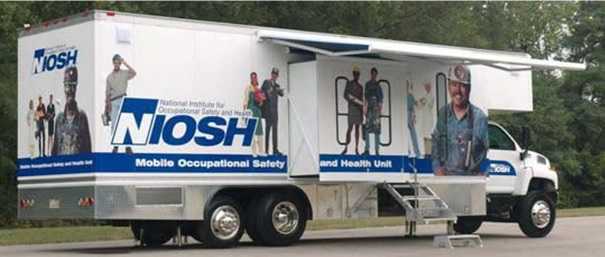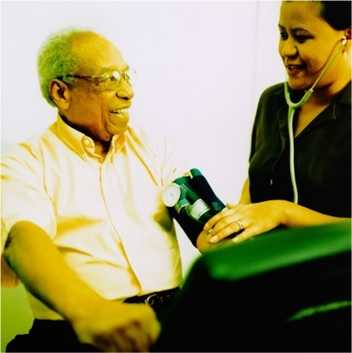NIOSH Research Rounds
NIOSH Research Rounds is a monthly bulletin of selected research conducted by researchers at NIOSH and NIOSH-funded researchers at other institutions.
Volume 3, Number 1 (July 2017)
Inside NIOSH:
Rapid Progression of Black Lung Disease Highlights Need for Regular Screening
Many coal miners who initially had a normal imaging test developed the most severe form of coal-dust—related lung disease within 21 years, and some within 10 years, according to a recent NIOSH study published in the journal Occupational and Environmental Medicine. These findings highlight the importance of regular chest imaging, or radiography, and lung function tests for all coal miners.
Work-related lung disease among coal miners, also known as black lung disease, results from breathing in coal mine dust, which causes inflammation and scarring, or fibrosis, in the lungs. Coal mine dust can also cause chronic obstructive pulmonary disease, or COPD. Regular screening is critical to catch early stages of black lung disease so that steps can be taken to prevent progression to severe disease. In the United States, coal miners are entitled to receive free screening when they start working in the industry and about every 5 years after that for as long as they keep working in coal mining. NIOSH recommends that miners take advantage of this important opportunity.
Black lung disease is severe, often deadly, and has no cure. It is also entirely preventable by avoiding exposure to coal dust. After decades of decline, however, the occurrence of advanced black lung disease, known as progressive massive fibrosis, recently began to climb, especially in central Appalachia.
To understand this increase, NIOSH investigators analyzed data from the Coal Workers’ Health Surveillance Program. The NIOSH program provides the opportunity for all current coal miners to receive confidential health screenings at no cost to the miner. The investigators identified 192 miners who developed severe lung disease after the year 2000 and who had received at least two chest radiographs. It was found that most of these miners had a normal initial radiograph before progressing to severe lung disease nearly 21 years later, on average. Although almost half of the miners progressed from normal to severe lung disease in more than 20 years, 16.6% progressed in less than 10 years, and 35% in 11–20 years. Participants’ average age at the beginning of the study was 29 years, and all were male. Most worked in Kentucky, Virginia, or West Virginia.

The NIOSH mobile testing unit depicted above provides confidential health screenings at no cost to miners as part of the Coal Workers’ Health Surveillance Program. Photo from NIOSH.
More information is available:
In This Issue
NIOSH Research Rounds is Brought to You By:
- John Howard, M.D., Director
- Christina Spring, Editor in Chief
- Anne Blank, Story Editor
- Cathy Rotunda, Copy Editor
- Glenn Doyle, Technical Lead
- Tonya White, Technical Support
Get Email Updates
Subscribe to the NIOSH Research Rounds Newsletter:
Outside NIOSH
What is Total Worker Health®?
Total Worker Health® (TWH) is defined as policies, programs, and practices that integrate protection from work-related safety and health hazards with promotion of injury and illness prevention efforts to advance worker well-being. TWH explores opportunities to not only protect workers, but also advance their health and well-being by targeting the conditions of work. TWH approaches recognize that job-related factors such as wages, hours of work, workload and stress levels, interactions with coworkers, and access to leave and healthful workplaces all can have an important impact on the well-being of workers, their families, and their communities.
The following three articles summarize NIOSH-funded projects that focus on TWH strategies related to ergonomics and worker stress.
More information is available:
- NIOSH Total Worker Health®
- NIOSH Centers of Excellence for Total Worker Health®
- Fundamentals of Total Worker Health® Approaches: Essential Elements for Advancing Worker Safety, Health, and Well-Being

Regular planning meetings, subject matter experts in ergonomics and health, and training are essential to implementing a Total Worker Health program. Thinkstock
Total Worker Health® Toolkit Developed
If your workplace follows the guidelines for Total Worker Health® (TWH) approaches, you may find that you enjoy going to work. You may also find that you have time for family and social commitments, as well as enough sleep and exercise. But, while you may recognize and enjoy the effects of TWH interventions, how does a workplace start a program?
To address that question, NIOSH-funded investigators at University of Massachusetts Lowell and University of Connecticut, in Farmington and Storrs, developed and tested a toolkit for starting a TWH program, according to new research published in the journal Applied Ergonomics. Based on ergonomics, which is the study of comfortable and functional equipment design, the toolkit includes guides for forming committees to design and manage a TWH program, training committee members, and establishing a structured process for workplace participation.
Working with four different organizations, investigators identified three components critical to the success of a TWH program. First, the organization must be committed to holding regular meetings with a trained facilitator to plan the design of the program. Second, subject matter experts in ergonomics and health are a fundamental part of designing a successful program. Third, it is important to train new committee members to replace departing members. The study also showed that two committees increased planning, communications, and teamwork skills, compared to a single committee. One of the committees was an employee-run design committee, and the other was a management steering committee. Throughout the study, investigators used information from program organizers and participants to develop new and improved versions of the toolkit.
More information is available:
- Field Tests of a Participatory Ergonomics Toolkit for Total Worker Health®
- Center for Promotion of Health in the New England Workplace
Lifting Equipment Linked to Fewer Injuries among Nursing Home Workers
Injuries among nursing home workers significantly decreased after the start of a safety program that included mechanical lifting equipment and training on how to use it, according to a NIOSH-funded study at the University of Massachusetts Lowell published in the journal Safety Science.
Compared to workers in other occupations, nursing home workers have a higher rate of work-related injury to the muscles and bones. In fact, musculoskeletal injury results in more days of work missed among nursing home workers than among construction workers, according to the U.S. Bureau of Labor Statistics. Often, these injuries result from tasks that involve manually lifting or moving nursing home residents. Consequently, occupational safety and health specialists are interested in whether mechanical lifting equipment can help reduce injury and protect workers.
For this 8-year study, investigators compared injury rates from before a safety program began to after the program had been in place for 6 years. Started by a large healthcare corporation to reduce musculoskeletal injuries, the program included purchasing mechanical lifting equipment and training workers to use it. The program also provided the nursing homes with detailed procedures for using and maintaining the equipment.
Using workers’ compensation claims, the investigators compared injury rates for 136 nursing homes in 11 states employing 18,571 full-time employees annually, on average. Claims related to resident handling decreased by 32% within the first 3 years of the study and by 38% within 4 to 6 years. Overall, injury claims decreased in 72% of participating centers after 6 years, and resident-handling claims decreased by 82%. Based on these findings, the investigators concluded that mechanical lifting equipment helped reduce injuries among the nursing home workers in this study. Since injuries still occurred, however, more research is necessary to understand the causes and prevention of musculoskeletal injury among nursing home workers.
More information is available:
- Injury Rates Before and After the Implementation of a Safe Resident Handling Program in the Long-term Care Sector
- Center for Promotion of Health in the New England Workplace

A computer simulation showed that perceived stress among nursing home aides decreased with greater job control and lower job demands. Thinkstock
Computer Simulation Links More Job Control, Lower Job Demands to Decreased Stress
A computer simulation of system dynamics modeling showed that greater job control and lower job demands had the greatest impact on perceived stress among nursing home aides, NIOSH-funded investigators report in the journal BMC Health Services Research. System dynamics modeling is a method for researching complex relationships.
A computer simulation enables investigators to evaluate a system dynamics model depicting interactive relationships, in this case between worker stress and specific workplace conditions. To develop the model, investigators recruited eight volunteer participants with knowledge of work conditions in nursing homes who had participated in a previous large study of U.S. nursing home workers. Through brainstorming sessions, study participants identified work-related influences on stress. The investigators then divided these influences into related groups, which they used to program various workplace scenarios into the computer model.
Although stress decreased in scenarios with greater job control and lower job demands, the effects of workplace social support from managers and coworkers, workplace safety, and personal demands such as work-family conflict were less impactful. Since this finding differs from those of previous studies, additional research is necessary to confirm the results of this study. Still, the study shows the benefit of system dynamics modeling in identifying the interactive causes of stress in large organizations, such as nursing homes, and pinpointing areas for intervention, according to the investigators.
More information is available:
- Conceptualizing the Dynamics of Workplace Stress: A Systems-based Study of Nursing Aides
- Center for Promotion of Health in the New England Workplace
Disclaimer
Mention of any company or product does not constitute endorsement by NIOSH.
- Page last reviewed: July 18, 2017
- Page last updated: July 18, 2017
- Content source:
- National Institute for Occupational Safety and Health (NIOSH) Office of the Director


 ShareCompartir
ShareCompartir